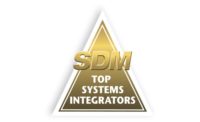Back when video surveillance relied on tape-based VCRs for recording, deploying these systems was fairly straightforward. You simply connected the camera or cameras directly to the VCR and — voila — everything was captured on tape. Retention depended on how often you wanted to switch out the tape and how much cabinet space you had to store tapes.
Today’s video surveillance systems are much, much more complex, offering an array of functionality that was unheard of just a couple of decades ago. Deploying and configuring NVRs — and to some extent DVRs — requires not only a certain degree of networking know-how but also a number of other factors, including careful calculation to determine how much storage is required.
When it comes to working with these video recording solutions, there are a number of challenges security integrators may face, the most common of which are discussed here.
Bandwidth & Storage
The first and perhaps the most important challenge integrators will encounter is determining just what products are required based on an end user’s storage and retention needs, coupled with the number and resolution of the cameras that will be used. Many software vendors will provide a minimum spec, but there is much more to it than that, says Kelly Kellen, marketing director, BCDVideo, Buffalo Grove, Ill.
“There are a number of factors involved. You have to look at the whole ecosystem of how this is all being laid out, and then future-proof it,” she says.
Like most NVR providers, BCDVideo offers a storage calculator that not only helps plan solutions for the present, but also with a look to the future.
Navigating the Sales Process
From a sales perspective, keeping up with new technologies, particularly in the age of IoT, can be tough because the various technologies are going to impact bandwidth and storage considerations. If you’re trying to bring together a best-in-breed solution, it can be difficult to know exactly what options are available, says Mitch Mershon of Axis Communications.
“There’s new technology coming out every day that as integrators you might not know about, but the sales team for the vendor will say, ‘This is the perfect solution for you.’ So you really need to keep up with technology, and the best way to do that is to have a great relationship with all your vendors or manufacturers,” he says. “That is the best way to truly design and put together a system and make sure that you’re using the tools available to you.”
According to Mershon, every manufacturer will offer some type of sales tool, whether it’s a design tool, a pricing tool or something else.
Being familiar with a couple of these tools will alleviate some of the concern, especially when planning for potential future expansion.
“It comes down to that knowledge and being able as a salesperson to expand the system without breaking the bank,” Mershon says. “It’s always going to be a balance between how much they’re willing to spend, how much they can spend, and the functionality of the system.”
“Those upfront calculations are important, and it helps them think through all of the details and the longevity of the project. We have a storage calculator that we use that incorporates frame rates, duration, and all of those things to help an integrator ask the right questions to get the end user thinking about not just the short term, but the long term,” Kellen says.
Setting realistic storage expectations is something security integrator NAVCO, based in Fullerton, Calif., deals with on a regular basis, because the resolution of today’s cameras can really strain customers’ bandwidth and storage resources, says Merle Hughes, the company’s group operations manager, Southwest region.
“What we try to push is that we want cameras on their own LAN and their own network so we’re not pulling that bandwidth across the customer’s network,” Hughes says. “That’s a big thing from the design and the initial concept, trying to make sure we don’t get out there and have a fantastic camera system that brings the customer’s network to its knees.”
Setup & Configuration
The second challenge integrators often encounter with NVRs is finding a way to ensure that installation and configuration go smoothly and require the least amount of time and labor, says Vihar Soni, marketing manager, Matrix Comsec Pvt. Ltd., Vadodara, India.
“Systems integrators’ biggest assets are their manpower — who does the implementation of the project. Time is precious to complete the project on time and this requires their workforce to work seamlessly, hassle-free and fast. A lot of time is consumed to connect the cameras to the NVR and get them live,” he says.
Therefore, the system must take minimal time to be functional for customers’ needs and must be easily understood to help reduce labor costs.
One of the biggest challenges facing integrators is the installation of NVRs and IP cameras. In order for integrators to be successful, their installation time and labor needs to be efficient and easy.
“With the current number of IP cameras and NVR manufacturers in the industry all utilizing slightly different protocols and standards, integrators are faced with a daunting challenge of being able to put together an IP security system in a timely and cost-effective manner,” says Mike Tabola, senior product manager, security products, building technologies and solutions, Johnson Controls, Milwaukee. ”Training on the various equipment deployed by integrators is also a major issue. Integrators will typically be responsible for installing multiple camera lines across a network, and knowing how the camera lines integrate to the NVR platform can be a challenge.”
According to Michael Hendrix, director of sales engineering, Hikvision USA, City of Industry, Calif., connecting the NVR or DVR to the internet for remote viewing is typically a major challenge for integrators.
“Especially in residential and small business environments, the end users want to see their cameras and facility while they are away from the site, and the initial registration and connection to the internet tends to take up the most time,” Hendrix says.
This is why many manufacturers have included features that simplify deployment and configuration.
“One of the features that NVR manufacturers can develop to assist integrators is an efficient camera discovery tool that automatically discovers the cameras that are on the network and can assign IP addresses to those cameras,” Tabola says. “This will aid the integrator by decreasing the time and labor in having to connect individually to each camera. There are several tools that will help the integrator address these challenges, including wizards with limited number of steps, QR codes, and security guides.”
Integration & Compatibility
The primary goal of the ONVIF standard is to ensure interoperability between different manufacturers’ products, but the implementation of the standard can vary from manufacturer to manufacturer. So, while a number of recorders claim to support particular lines of cameras, the reality is that all too often during installation, it becomes clear that while the recorder technically supports the camera, it may not support some of the features.
“It’s not a full integration,” Hughes explains. “A good example would be a 360-deg. camera. Yes, the NVR supports it, but what you find out once you get the camera installed is that maybe their means of dewarping that camera is not up to par with what the camera manufacturer can do. So you end up with a 12-megapixel, 360-deg. camera that has an out-of-focus and badly dewarped image, which is really not usable.”
Therefore, one of the most frustrating pieces of a surveillance puzzle is having an NVR software interface that doesn’t allow for full functionality of all of a camera’s settings, making it particularly difficult to provide customers with the best possible image, says Christopher Tamez, CEO, Allied Security Links, Austin, Texas. This includes nighttime scenes where many factors come into play, the greatest of which is lighting.
“There’s a good chance you’re not at the customer’s property when it finally gets dark, so the camera needs to be adjusted based on those parameters,” he says. “If you leave the camera on the basic settings, you will only get an average image. With the technologies offered on today’s IP cameras — automatic gain control, wide dynamic range, exposure rate, etc. — you really need to have access to all settings.”
In cases where there is limited access to camera settings through the software, there are a few ways to work around it. First, Tamez says, you can set up a remote viewing app and log in directly to the NVR server, to then log into the camera’s user interface to achieve full functionality of the camera’s settings.
Second, if the NVR software automatically assigns a camera as an ONVIF device, there is a good chance that not all of the camera setting options will be available.
The Cyber Security Challenge
Any internet-connected device can become a potential entry point for hackers, so the industry’s shift from analog to IP solutions has made cyber security a paramount concern for integrators and end users alike.
“You’re putting an actual computer on a customer’s network, and in cyber security it’s always the weakest link that’s going to be the vector of attack,” says David Grey, product manager, appliances, Genetec Security, Montreal. “So if you’re putting an unsecured NVR or DVR onto that customer’s network, you can be leaving that customer exposed and vulnerable.”
First and foremost, it’s important to make sure NVRs are not using default passwords, which can be easily found online.
“Does the unit allow the default password to remain or does it require it to be changed on first login?” Grey says.
Integrators will want to look for products that follow best cyber security practices to ensure the NVR doesn’t become the weakest link on the network. Additionally, most manufacturers offer hardening guides that provide insight and direction on how to adjust units’ settings to deliver strong cyber security that meets end users’ needs.
“Sometimes this can be overcome by manually switching it from ONVIF to both its real make and model, or if the software doesn’t provide the make and model, you can use the manufacturer and select option for generic,” Tamez says. “This option will typically give you a few more options to make changes remotely than if left in ONVIF option.”
Compatibility has become better over the years, says Paul Spruiell, vice president of operations, West region, NAVCO, Fullerton, Calif., but many times that isn’t addressed ahead of the sale. For integrators selling multiple lines of brands, there is a higher risk of making a mistake if salespeople do not do their homework to verify that camera X is compatible with DVR Y.
“We ran into that early on. It’s getting better, but it’s still a problem,” he says.
Ongoing Maintenance & Monitoring
Once an NVR has been sold and installed as part of the overall surveillance solution, the next phase is to look at how to keep that system running in the future. This is an area where security integrators have the opportunity to continue that relationship with an end user without coming off as a salesperson.
“You can offer a type of health monitoring that can be offered on a subscription basis to the end user; because the worst thing you can have as an end user is to have an event occur at your location, then go back to search for the video and not have it,” says Mitch Mershon, program manager, medium business, Axis Communications, Chelmsford, Mass.
Many providers include network monitoring features in their NVRs to allow integrators to stay on top of their customers’ solutions and potentially avoid problems before they can even occur.
“If a security integrator can provide that service to an end user, and they can stay ahead of it, it actually saves them a lot of money and truck rolls,” Kellen says. “No one wants to discover a problem after the fact. If the camera is down and did not record video, I have an unhappy customer. They may be in a pickle because they have a slip-and-fall situation and they can’t grab the video.”
Therefore, professional, secure, and easy-to-use security user and administration interfaces are a key starting point, available from many manufacturers.
“Having analytics on the DVR or NVR that can warn in advance of upcoming performance issues, disk capacity and disk health is a major tool to increase system reliability to avoid having lost video, even on systems with RAID data protection,” says Jeff Whitney, vice president of marketing, Arecont Vision Costar, Glendale, Calif. “Several manufacturers offer this capability in varying degrees of predicting and monitoring DVR or NVR system or disk issues and automatic alerting, which will continue to improve as future products add effective AI or machine-learning technology.”
With this in mind, integrators should absolutely be looking for these types of features when selecting recording solutions for their customers, Whitney says.
“DVRs were pretty much dumb devices when first rolled out,” Whitney says. “Today’s best platforms are very different. They offer remote access to both video and to perform administrative or diagnostic tasks, a major cost and time saver by eliminating trips to the customer site or remote location to dramatically reduce truck rolls. Selecting a DVR/NVR platform that includes this capability is a necessary starting point whenever multiple sites will be using the same surveillance platform.”
Software Updates
Another part of the ongoing maintenance is to ensure customers’ products are running the most recent version of the software that drives them. Whether for cyber security or feature and functionality updates, every system will require regular software updates throughout its lifecycle.
“After a system has been commissioned, firmware updates that may address new features or cyber security vulnerabilities will need to be deployed from time to time,” says Troy Wideman, regional marketing manager, Bosch Security and Safety Systems, Fairport, N.Y. “Software tools available from the manufacturer can scan a network and identify connected devices, such as NVRs and cameras, and be used to upload new firmware versions to multiple cameras and devices at one time. This also reduces integrator labor costs for upgrades.”
However necessary these updates may be, the process is not always a smooth one, because updates for every IP device in the overall surveillance system are rarely, if ever, released at the same time.
“If you’re mixing and matching manufacturers, you might find that you update the NVR, and all of a sudden you have a camera problem because they’re not the same manufacturer,” Hughes says. “Maybe this firmware was tested when you installed the camera and everything was compatible. But, now that you’ve updated the NVR, there’s a problem between the firmware of the camera and the NVR that you have to go back and fix after the fact.
“You need to do the research before you start updating the firmware to make sure you’re not going to create more problems than you solve,” he adds.
Some manufacturers offer tools that allow NVRs to automatically download and install updates as they are available. Unfortunately, not everyone takes advantage of this valuable function, says Robert Wegner, vice president of support, Hanwha Techwin America, Ridgefield Park, N.J.
“Out of the box, machines have the ability to automatically update with any firmware updates, especially for security, but it can be disabled,” he says. “It can be enabled or disabled but it’s pretty much automatic if you leave it alone.”
More Online
For more information about video storage, please visit SDM’s website where you will find the following articles.
6 Keys to Successful Video Storage
www.SDMmag.com/6-keys-successful-video-storage
Feeding the Growing Appetite for Video Surveillance Data
www.SDMmag.com/growing-appetite-video-data
Knacks for Successful Video Recording
www.SDMmag.com/knacks-successful-video-recording
3 Main Ingredients for Video Storage Success








